2021 Peugeot 308 tow
[x] Cancel search: towPage 65 of 244

63
Safety
5With GTi version
► Press this button to deactivate DSC
and ASR.
Except GT
i version
► Select " Traction control " from the
"Driving functions " menu on the touch
screen to deactivate ASR.
Deactivation is confirmed when this
indicator lamp is displayed on the
instrument panel accompanied by a message
and, depending on version, the lighting of the
indicator lamp in the button.
Reactivate the system(s) when normal grip is
restored.
This/these system(s) is/are reactivated
automatically each time the ignition is switched
off or above 31 mph (50
km/h) (except GTi
version).
Below 31 mph (50
km/h), reactivate them
manually.
With GTi version
► Press this button again to reactivate
DSC and ASR.
Except GTi version
► Select Traction control from the
Driving functions menu on the touch
screen to reactivate ASR.
Malfunction
In the event of a malfunction of these
systems, this warning lamp comes on,
accompanied by the display of a message and
an audible signal.
Contact a PEUGEOT dealer or a qualified
workshop to have the systems checked.
ASR / DSC
These systems enhance safety during
normal driving, but should not encourage
the driver to take extra risks or drive at high
speed.
It is in conditions of reduced grip (rain, snow,
ice) that the risk of loss of grip increases. It
is therefore important for your safety to keep
these systems activated in all conditions, and
particularly in difficult conditions.
Correct operation of these systems depends
on compliance with the manufacturer's
recommendations relating to the wheels
(tyres and rims), braking and electronic
components, as well as the assembly and
repair procedures used by PEUGEOT
dealers.
The use of snow tyres is recommended, to
ensure that these systems remain effective
in winter conditions. All four wheels must be
fitted with tyres approved for the vehicle.
Trailer stability assist (TSA)
When towing, this system reduces the risk of the
vehicle or trailer swaying.
Operation
The system is activated automatically when the
ignition is switched on.
The electronic stability control system (ESC)
must not have any faults.
At speeds between 37 and 99 mph (60 and
160
km/h), if the system detects oscillating trailer
movements (snaking), it applies the brakes to
stabilise the trailer and, if necessary, reduces
engine power to slow the vehicle.
This warning lamp flashes on the instrument panel and the brake lamps
light up to draw attention to this corrective action.
For information on weights and towed loads,
refer to the Engine Technical Data and Towed
Loads section or your vehicle’s registration
certificate
To ensure safe driving with a Towing device,
refer to the corresponding section.
Malfunction
If a fault occurs, this warning lamp comes
on in the instrument panel, accompanied
by a message and an audible signal.
If you wish to continue towing a trailer, reduce
your speed and drive carefully!
Contact a PEUGEOT dealer or a qualified
workshop to have the system checked.
Page 69 of 244
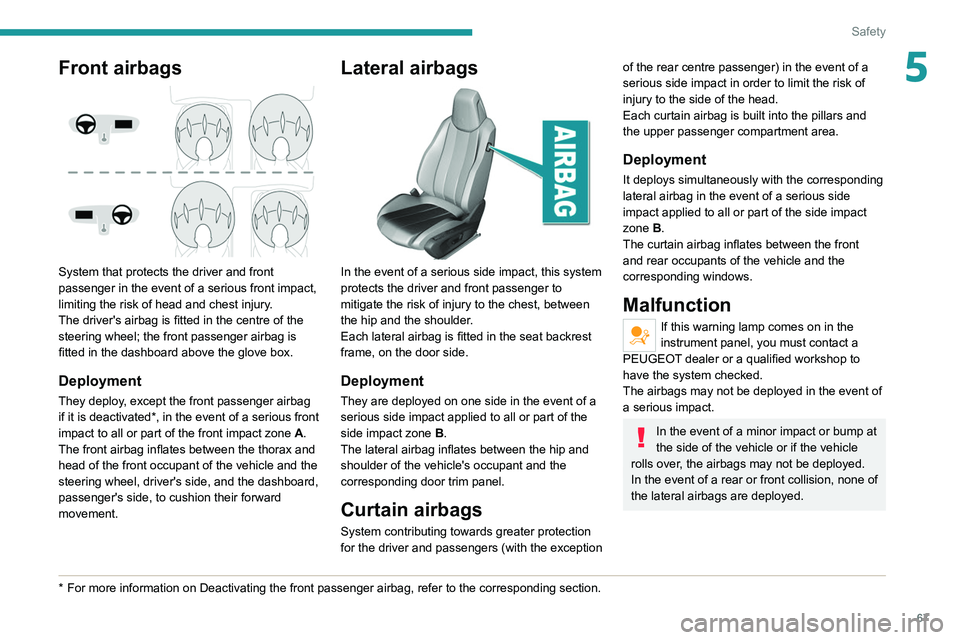
67
Safety
5Front airbags
System that protects the driver and front
passenger in the event of a serious front impact,
limiting the risk of head and chest injury.
The driver's airbag is fitted in the centre of the
steering wheel; the front passenger airbag is
fitted in the dashboard above the glove box.
Deployment
They deploy, except the front passenger airbag
if it is deactivated*, in the event of a serious front
impact to all or part of the front impact zone A.
The front airbag inflates between the thorax and
head of the front occupant of the vehicle and the
steering wheel, driver's side, and the dashboard,
passenger's side, to cushion their forward
movement.
* For more information on Deactivating the front passenger airbag, refer t\
o the corresponding section.
Lateral airbags
In the event of a serious side impact, this system
protects the driver and front passenger to
mitigate the risk of injury to the chest, between
the hip and the shoulder.
Each lateral airbag is fitted in the seat backrest
frame, on the door side.
Deployment
They are deployed on one side in the event of a
serious side impact applied to all or part of the
side impact zone B.
The lateral airbag inflates between the hip and
shoulder of the vehicle's occupant and the
corresponding door trim panel.
Curtain airbags
System contributing towards greater protection
for the driver and passengers (with the exception
of the rear centre passenger) in the event of a
serious side impact in order to limit the risk of
injury to the side of the head.
Each curtain airbag is built into the pillars and
the upper passenger compartment area.
Deployment
It deploys simultaneously with the corresponding
lateral airbag in the event of a serious side
impact applied to all or part of the side impact
zone B.
The curtain airbag inflates between the front
and rear occupants of the vehicle and the
corresponding windows.
Malfunction
If this warning lamp comes on in the
instrument panel, you must contact a
PEUGEOT dealer or a qualified workshop to
have the system checked.
The airbags may not be deployed in the event of
a serious impact.
In the event of a minor impact or bump at
the side of the vehicle or if the vehicle
rolls over, the airbags may not be deployed.
In the event of a rear or front collision, none of
the lateral airbags are deployed.
Page 75 of 244
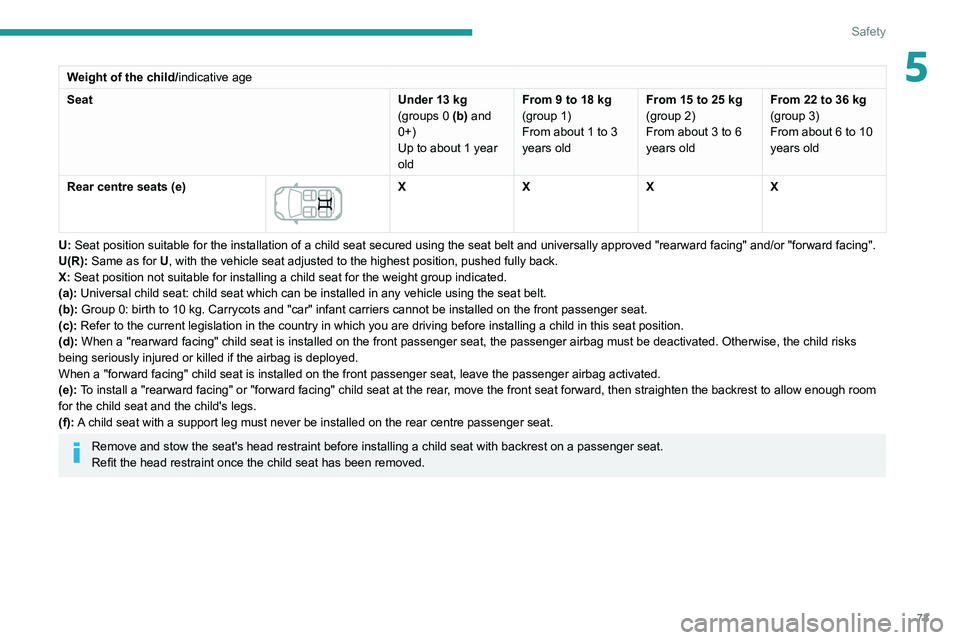
73
Safety
5Weight of the child/indicative age
Seat Under 13
kg
(groups
0 (b) and
0+)
Up to about 1 year
old From 9 to 18
kg
(group 1)
From about 1 to 3
years old From 15 to 25
kg
(group 2)
From about 3 to 6
years old From 22 to 36
kg
(group 3)
From about 6 to 10
years old
Rear centre seats
(e)
X XXX
U: Seat position suitable for the installation of a child seat secured usi\
ng the seat belt and universally approved "rearward facing" and/or "forw\
ard facing".
U(R): Same as for U, with the vehicle seat adjusted to the highest position, pushed fully b\
ack.
X: Seat position not suitable for installing a child seat for the weight g\
roup indicated.
(a): Universal child seat: child seat which can be installed in any vehicle \
using the seat belt.
(b): Group 0: birth to 10
kg. Carrycots and "car" infant carriers cannot be installed on the front\
passenger seat.
(c): Refer to the current legislation in the country in which you are drivin\
g before installing a child in this seat position.
(d): When a "rearward facing" child seat is installed on the front passenger\
seat, the passenger airbag must be deactivated. Otherwise, the child ri\
sks
being seriously injured or killed if the airbag is deployed.
When a "forward facing" child seat is installed on the front passenger s\
eat, leave the passenger airbag activated.
(e): To install a "rearward facing" or "forward facing" child seat at the rear\
, move the front seat forward, then straighten the backrest to allow eno\
ugh room
for the child seat and the child's legs.
(f): A child seat with a support leg must never be installed on the rear centr\
e passenger seat.
Remove and stow the seat's head restraint before installing a child seat\
with backrest on a passenger seat.
Refit the head restraint once the child seat has been removed.
Page 76 of 244
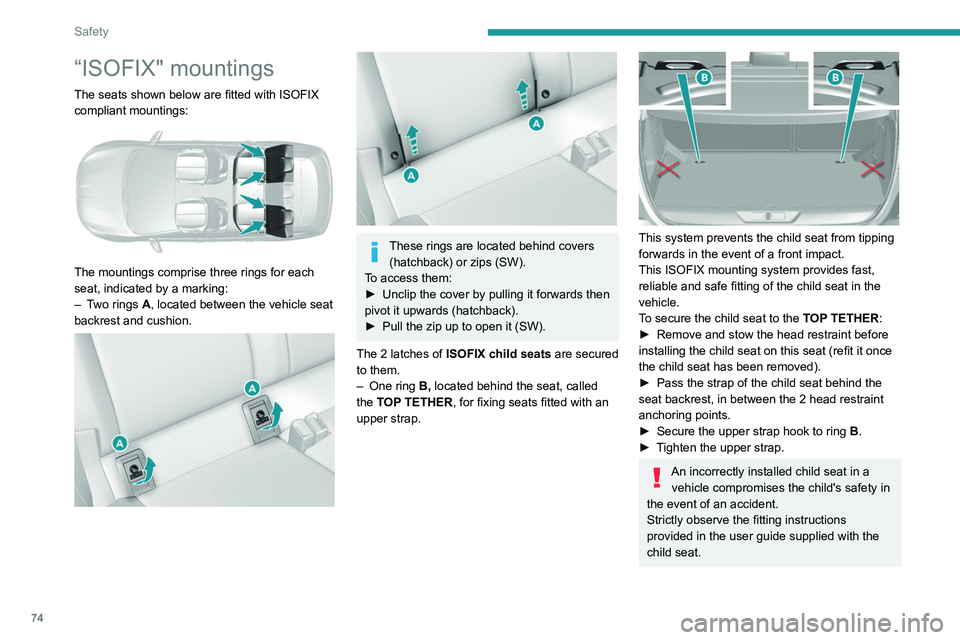
74
Safety
“ISOFIX" mountings
The seats shown below are fitted with ISOFIX
compliant mountings:
The mountings comprise three rings for each
seat, indicated by a marking:
–
T
wo rings A, located between the vehicle seat
backrest and cushion.
These rings are located behind covers (hatchback) or zips (SW).
To access them:
►
Unclip the cover by pulling it forwards then
pivot it upwards (hatchback).
►
Pull the zip up to open it (SW).
The 2
latches of ISOFIX child seats are secured
to them.
–
One ring
B, located behind the seat, called
the TOP TETHER, for fixing seats fitted with an
upper strap.
This system prevents the child seat from tipping
forwards in the event of a front impact.
This ISOFIX mounting system provides fast,
reliable and safe fitting of the child seat in the
vehicle.
To secure the child seat to the TOP TETHER:
►
Remove and stow the head restraint before
installing the child seat on this seat (refit it once
the child seat has been removed).
►
Pass the strap of the child seat behind the
seat backrest, in between the 2 head restraint
anchoring points.
►
Secure the upper strap hook to ring
B
.
►
T
ighten the upper strap.
An incorrectly installed child seat in a vehicle compromises the child's safety in
the event of an accident.
Strictly observe the fitting instructions
provided in the user guide supplied with the
child seat.
For information about the options for
fitting ISOFIX child seats in your vehicle,
refer to the summary table.
If your vehicle has a spare wheel of the same
size as the other four wheels, follow the
procedure below:
► pass the strap and spring hook over the boot
floor (in the slot),
► raise the boot floor,
► lift out the upper storage box, located
alongside the wheel,
► attach the spring hook to the TOP TETHER
ring,
► refit the storage box and boot floor.
Recommended ISOFIX child
seats
Also consult the user guide from the child
seat’s manufacturer to find out how to
install and remove the seat.
Page 80 of 244
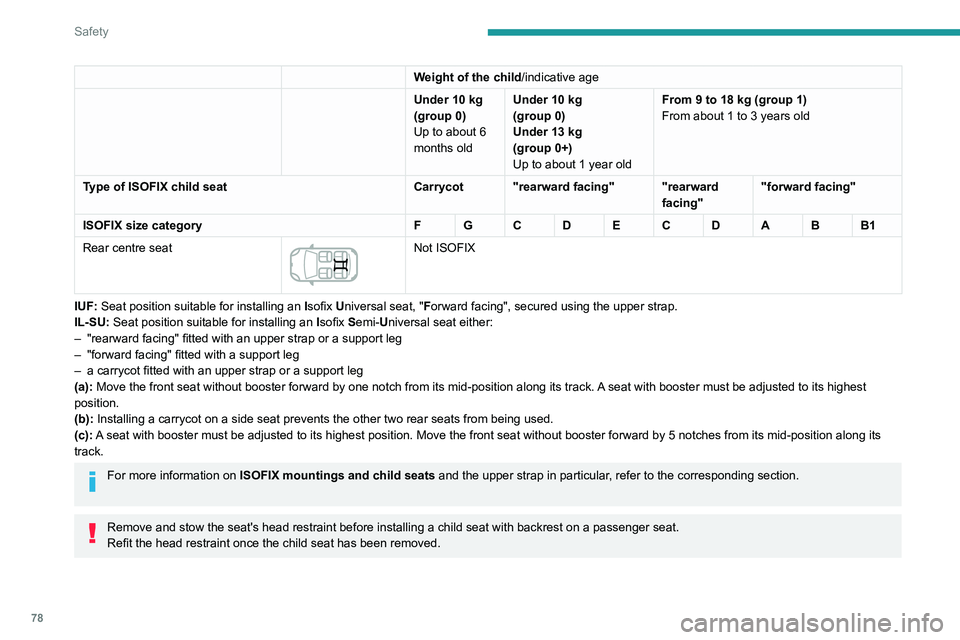
78
Safety
Weight of the child/indicative age
Under 10 kg
(group
0)
Up to about 6
months old Under 10
kg
(group
0)
Under 13
kg
(group
0+)
Up to about 1 year old From 9 to 18
kg (group 1)
From about 1 to 3 years old
Type of ISOFIX child seat Carrycot "rearward facing" "rearward
facing""forward facing"
ISOFIX size category F G C D E C D A B B1
Rear centre seat
Not ISOFIX
IUF: Seat position suitable for installing an Isofix Universal seat, "Forward facing", secured using the upper strap.
IL-SU: Seat position suitable for installing an Isofix Semi-Universal seat either:
–
"rearward facing" fitted with an upper strap or a support leg
–
"forward facing" fitted with a support leg
–
a carrycot fitted with an upper strap or a support leg
(a):
Move the front seat without booster forward by one notch from its mid-p\
osition along its track. A seat with booster must be adjusted to its highest
position.
(b): Installing a carrycot on a side seat prevents the other two rear seats \
from being used.
(c): A seat with booster must be adjusted to its highest position. Move the fr\
ont seat without booster forward by 5 notches from its mid-position alon\
g its
track.
For more information on ISOFIX mountings and child seats and the upper strap in particular, refer to the corresponding section.
Remove and stow the seat's head restraint before installing a child seat\
with backrest on a passenger seat.
Refit the head restraint once the child seat has been removed.
Child lock
This mechanical system prevents opening of a
rear door using its interior control.
The control is located on the edge of each rear
door and locking is independent for each door.
Locking
► Using the built-in key, turn the control as far
as it will go: • to the left on the left-hand rear door,
• to the right on the right-hand rear door.
Unlocking
► Using the built-in key, turn the control as far
as it will go: • to the right on the left-hand rear door,
• to the left on the right-hand rear door.
Page 83 of 244
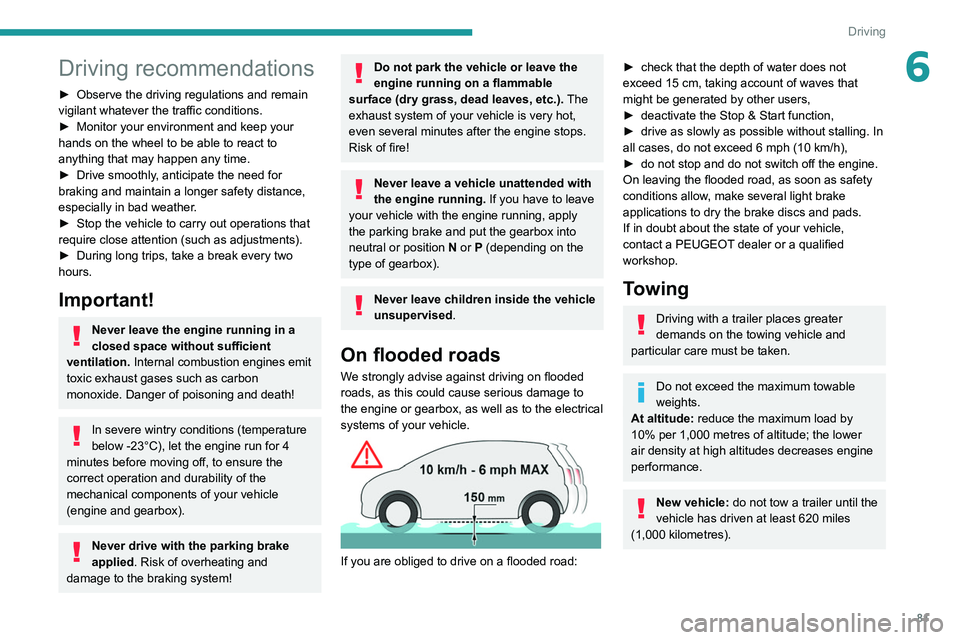
81
Driving
6Driving recommendations
► Observe the driving regulations and remain
vigilant whatever the traffic conditions.
►
Monitor your environment and keep your
hands on the wheel to be able to react to
anything that may happen any time.
►
Drive smoothly
, anticipate the need for
braking and maintain a longer safety distance,
especially in bad weather.
►
Stop the vehicle to carry out operations that
require close attention (such as adjustments).
►
During long trips, take a break every two
hours.
Important!
Never leave the engine running in a
closed space without sufficient
ventilation. Internal combustion engines emit
toxic exhaust gases such as carbon
monoxide. Danger of poisoning and death!
In severe wintry conditions (temperature
below -23°C), let the engine run for 4
minutes before moving off, to ensure the
correct operation and durability of the
mechanical components of your vehicle
(engine and gearbox).
Never drive with the parking brake
applied . Risk of overheating and
damage to the braking system!
Do not park the vehicle or leave the
engine running on a flammable
surface (dry grass, dead leaves, etc.). The
exhaust system of your vehicle is very hot,
even several minutes after the engine stops.
Risk of fire!
Never leave a vehicle unattended with
the engine running. If you have to leave
your vehicle with the engine running, apply
the parking brake and put the gearbox into
neutral or position N or P (depending on the
type of gearbox).
Never leave children inside the vehicle
unsupervised.
On flooded roads
We strongly advise against driving on flooded
roads, as this could cause serious damage to
the engine or gearbox, as well as to the electrical
systems of your vehicle.
If you are obliged to drive on a flooded road:
► check that the depth of water does not
exceed 15 cm, taking account of waves that
might be generated by other users,
►
deactivate the Stop & Start function,
►
drive as slowly as possible without stalling. In
all cases, do not exceed 6 mph (10
km/h),
►
do not stop and do not switch off the engine.
On leaving the flooded road, as soon as safety
conditions allow
, make several light brake
applications to dry the brake discs and pads.
If in doubt about the state of your vehicle,
contact a PEUGEOT dealer or a qualified
workshop.
Towing
Driving with a trailer places greater
demands on the towing vehicle and
particular care must be taken.
Do not exceed the maximum towable
weights.
At altitude: reduce the maximum load by
10% per 1,000 metres of altitude; the lower
air density at high altitudes decreases engine
performance.
New vehicle: do not tow a trailer until the
vehicle has driven at least 620 miles
(1,000 kilometres).
Page 84 of 244

82
Driving
Starting with the key
The parking brake must be applied.
► With a manual gearbox in neutral, fully
depress the clutch pedal.
► With an automatic gearbox in mode P or N,
fully depress the brake pedal.
► Insert the key into the ignition switch.
– The system recognises the starting code.
► Unlock the steering column by simultaneously
turning the steering wheel and the key.
In some cases, you may have to apply
some force to turn the wheels (if the
wheels are turned against a kerb, for
example).
► With a petrol engine, operate the starter
motor by turning the key to position 3 without
pressing the accelerator pedal, until the engine
starts. As soon as the engine starts, release the
key.
► With a Diesel engine, turn the key to position
2, ignition on, to operate the engine preheating
system.
► Wait until this warning lamp goes off in
the instrument panel, then turn the key to
position 3 without pressing the accelerator pedal,
to operate the starter motor until the engine
starts. As soon as the engine starts, release the
key.
If the outside temperature is high, let the
engine idle for 1 to 2 minutes after the
vehicle comes to a stop, to help it to cool.
Before setting off
Nose weight
► Distribute the load in the trailer so that the
heaviest items are as close as possible to the
axle and the nose weight (at the point where it
joins your vehicle) approaches the maximum
permitted without exceeding it.
Tyres
► Check the tyre pressures of the towing
vehicle and of the trailer , observing the
recommended pressures.
Lighting
► Check the electrical signalling on the trailer
and the headlamp beam height of your vehicle.
If a genuine PEUGEOT towing device is
used, the rear parking sensors will be
deactivated automatically to avoid the audible
signal.
When driving
Cooling
Towing a trailer uphill causes the coolant
temperature to increase. The maximum towable
load depends on the gradient and the exterior temperature. The fan’s cooling capacity does not
increase with engine speed.
►
Reduce speed and lower the engine speed to
limit the amount of heating produced.
In all cases, pay attention to the coolant
temperature.
If this warning lamp and the STOP
warning lamp come on, stop the
vehicle and switch off the engine as soon as
possible.
Brakes
Braking distances are increased when towing a
trailer. To avoid overheating the brakes, the use
of engine braking is recommended.
Side wind
Bear in mind that the vehicle will be more
susceptible to wind when towing.
Anti-theft protection
Electronic immobiliser
The key contains an electronic chip which has a
special code. When the ignition is switched on,
this code must be recognised in order for starting
to be possible.
This electronic engine immobiliser locks the
engine management system a few minutes after
the ignition is switched off, and prevents the
engine being started by anyone who does not
have the key.
In the event of a fault, you are informed
by illumination of this warning lamp, an
audible signal and a message in the screen.In
this case, your vehicle will not start; contact a
PEUGEOT dealer as soon as possible.
Keep safely, away from your vehicle, the
label attached to the keys given to you
when you purchased your vehicle.
Starting/Switching off the
engine, remote control
key
Place the gear lever into neutral.
Ignition switch
1.Stop position.
2.Ignition on position.
3.Starting position.
Page 85 of 244
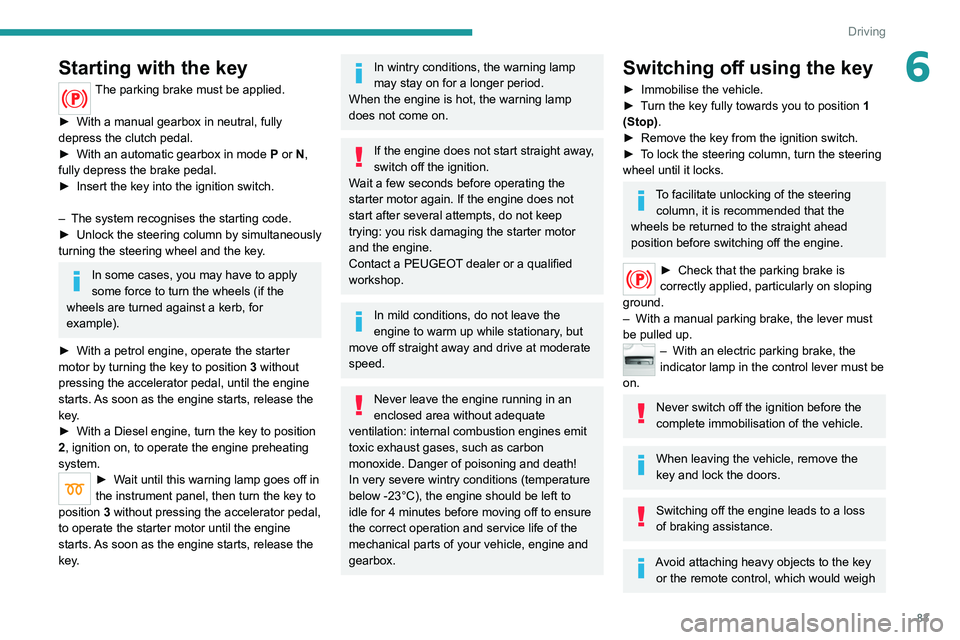
83
Driving
6Starting with the key
The parking brake must be applied.
►
With a manual gearbox in neutral, fully
depress the clutch pedal.
►
With an automatic gearbox in mode P
or N,
fully depress the brake pedal.
►
Insert the key into the ignition switch.
–
The system recognises the starting code.
►
Unlock
the steering column by simultaneously
turning the steering wheel and the key.
In some cases, you may have to apply
some force to turn the wheels (if the
wheels are turned against a kerb, for
example).
►
With a petrol engine, operate the starter
motor by turning the key to position 3
without
pressing the accelerator pedal, until the engine
starts. As soon as the engine starts, release the
key.
►
With a Diesel engine, turn the key to position
2
, ignition on, to operate the engine preheating
system.
► Wait until this warning lamp goes off in
the instrument panel, then turn the key to
position 3 without pressing the accelerator pedal,
to operate the starter motor until the engine
starts. As soon as the engine starts, release the
key.
In wintry conditions, the warning lamp
may stay on for a longer period.
When the engine is hot, the warning lamp
does not come on.
If the engine does not start straight away,
switch off the ignition.
Wait a few seconds before operating the
starter motor again. If the engine does not
start after several attempts, do not keep
trying: you risk damaging the starter motor
and the engine.
Contact a PEUGEOT dealer or a qualified
workshop.
In mild conditions, do not leave the
engine to warm up while stationary, but
move off straight away and drive at moderate
speed.
Never leave the engine running in an
enclosed area without adequate
ventilation: internal combustion engines emit
toxic exhaust gases, such as carbon
monoxide. Danger of poisoning and death!
In very severe wintry conditions (temperature
below -23°C), the engine should be left to
idle for 4 minutes before moving off to ensure
the correct operation and service life of the
mechanical parts of your vehicle, engine and
gearbox.
Switching off using the key
► Immobilise the vehicle.
► T urn the key fully towards you to position 1
(Stop).
►
Remove the key from the ignition switch.
►
T
o lock the steering column, turn the steering
wheel until it locks.
To facilitate unlocking of the steering column, it is recommended that the
wheels be returned to the straight ahead
position before switching off the engine.
► Check that the parking brake is
correctly applied, particularly on sloping
ground.
–
With a manual parking brake, the lever must
be pulled up.
– With an electric parking brake, the
indicator lamp in the control lever must be
on.
Never switch off the ignition before the
complete immobilisation of the vehicle.
When leaving the vehicle, remove the
key and lock the doors.
Switching off the engine leads to a loss
of braking assistance.
Avoid attaching heavy objects to the key or the remote control, which would weigh